Analytics21.12.2022
Imbalances in the RES market
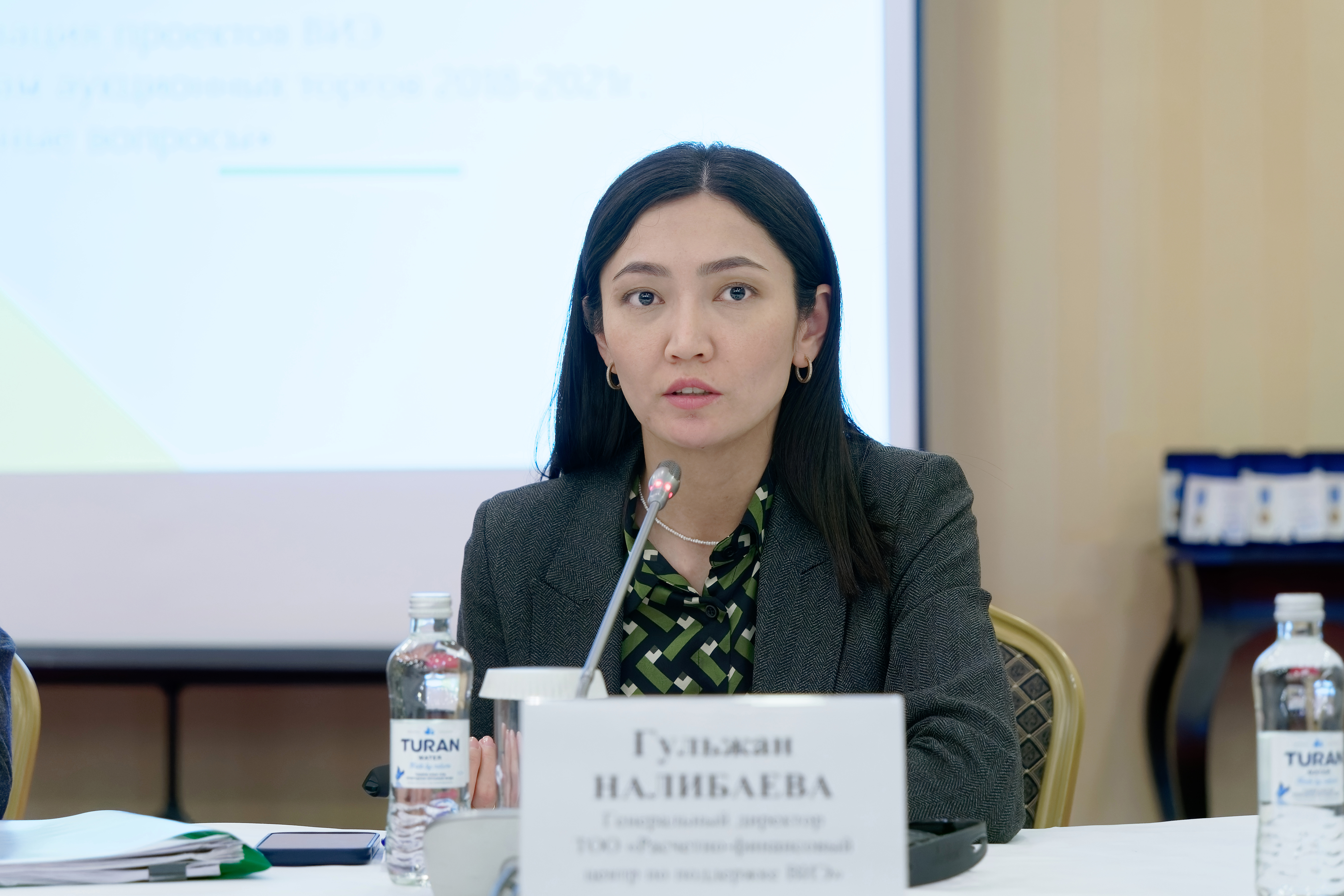
Gulzhan Nalibayeva, Director General, FSC of RE LLP
Today, the electric power industry is one of the most highly prioritized and attention¬demanding sectors of the country's economy. The established vector and targets for the development of this industry once again confirm the commitment of our state to all its obligations under all existing international agreements. At the same time, today's realities have shown that complete withdrawal from traditional energy sources is impossible today due to geopolitical and economic changes in the international arena.
1. OVERVIEW OF RES SECTOR
Adopted in 2013, "Concept for the transition of the Republic of Kazakhstan to a green economy" until 2050, provides for "green economy" principles as a direction for future development (increasing the share of renewable energy sources (RES) in total electricity production to 6% by 2025,15% by 2030 and 50% by 2050 with taking into account alternative energy). The country has set ambitious target indicators for development of "green economy", but progress and development shows that Kazakhstan is increasingly attracting foreign and domestic investors for construction of renewable energy facilities and the share of renewable energy in the energy system of Kazakhstan participating in the production of electric energy is growing every year.
Today, statistical indicators of renewable energy sector show the following picture.
As of the end of September 2022, the total installed capacity of renewable energy facilities in Kazakhstan reached 2,325 MW (accordingtothe Ministry of Energy of the Republic of Kazakhstan). Current trends in the development of RES in Kazakhstan indicate that the involvementof investors in construction of solar power plants prevail over other types of renewable energy (share of installed capacity of solar power plants is more than 49%).
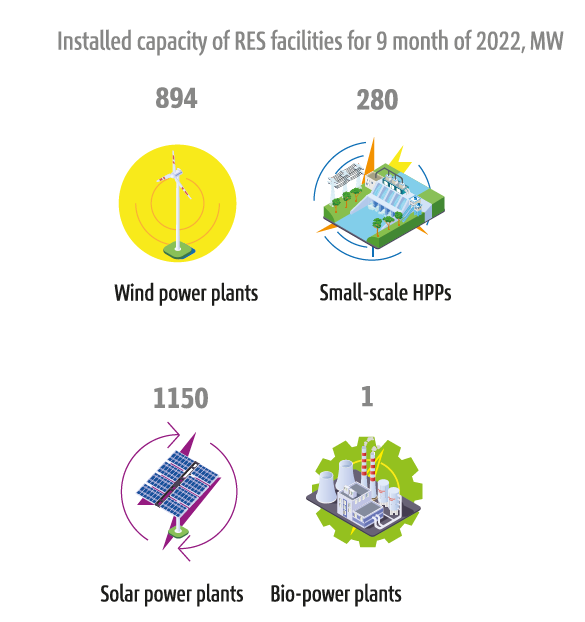
The share of generated RES energy in the total volume of electricity production in Kazakhstan for 9 months of 2022 amounted to 4.6% or 3,917 million kW. With that, large share of renewable energy generation falls to wind power plants, more than 41% or 1,639 million kW.
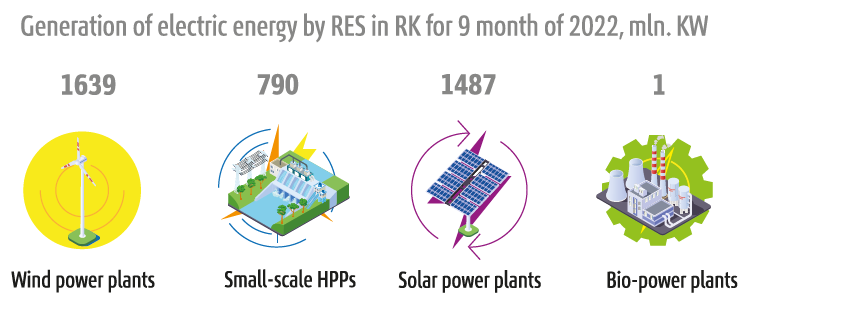
About 90% or 3,504.4 million kWh of renewable energy was sold through FSC of RE LLP. Wind power plants also account for the largestshareof electricity generation, more than 44% or 1,532 million kW.
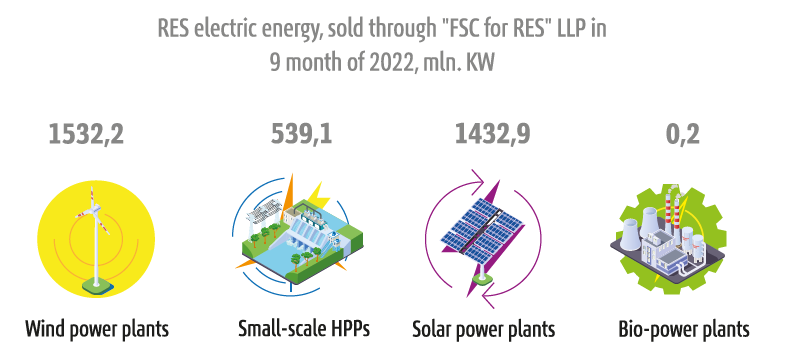
In accordance with the legislation in the field of renewable energy, the function of balance provider for renewable energy facilities is carried out by FSC of RE LLP within the framework of concluded long-term contracts, consolidating daily production schedules from 91 renewable energy facilities with total installed capacity of about 2,094 MW for all types of renewable energy.
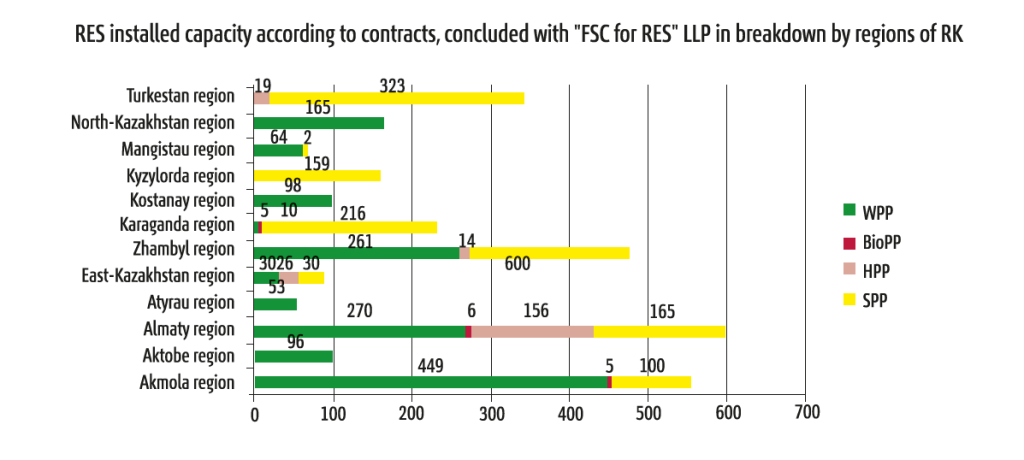 Installed Capacity Utilization Factor (ICUF) by region shows the natural and climatic potential of the region for each type of renewable energy. The average annual ICUF by region was calculated as the ratio of the actual electric power generation of each power plant to its maximum possible for each hour over the past 12 months (from September 2021 to September 2022).
Installed Capacity Utilization Factor (ICUF) by region shows the natural and climatic potential of the region for each type of renewable energy. The average annual ICUF by region was calculated as the ratio of the actual electric power generation of each power plant to its maximum possible for each hour over the past 12 months (from September 2021 to September 2022).
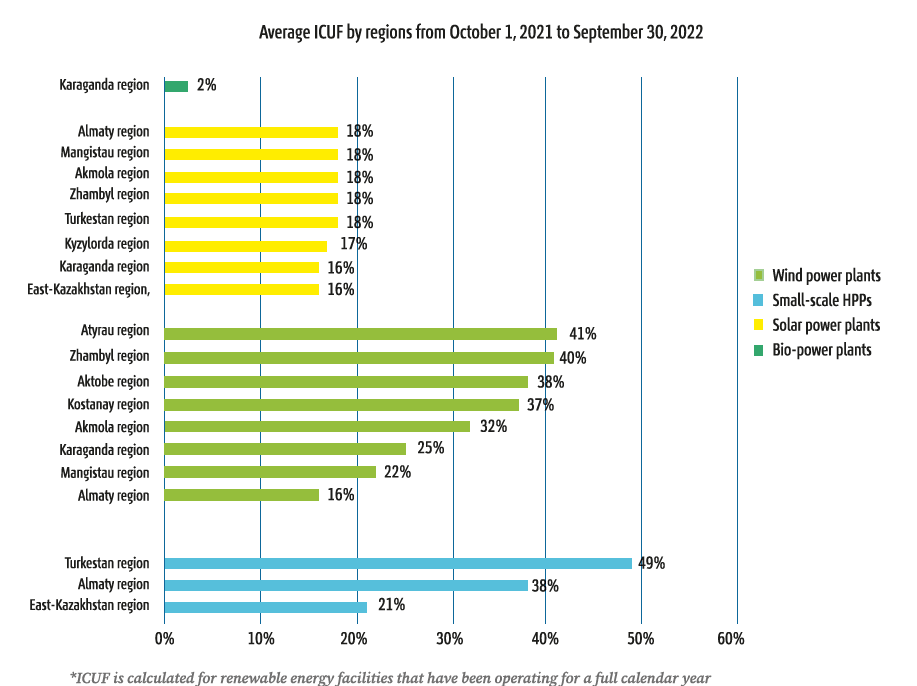
The above graph shows that there are sufficiently high resource indicators for SPP projects mainly in the south and west of Kazakhstan, as well as wind resources in the northern regions, Atyrau and Zhambyl regions.
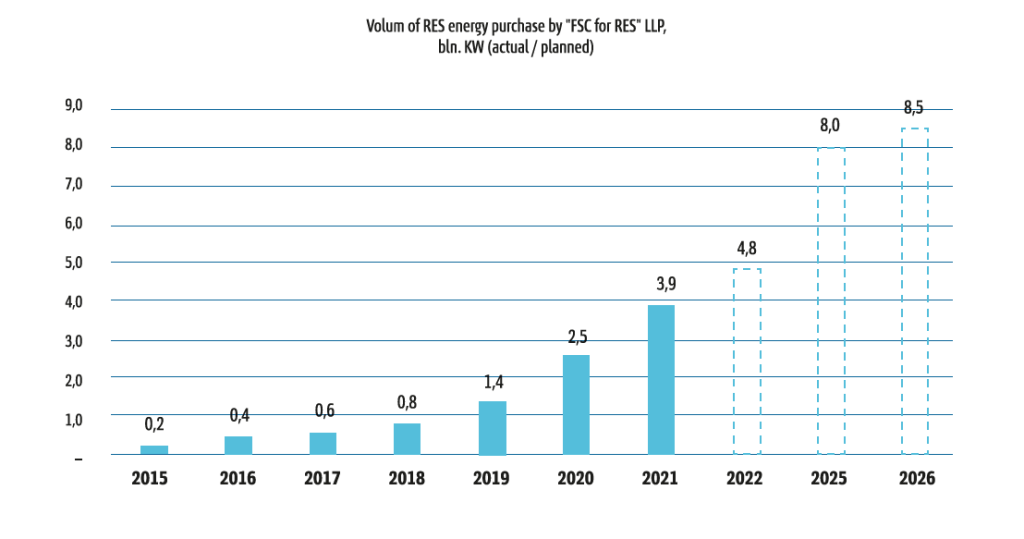
2. ANALYSIS OF RES IMBALANCES FOR 9 MONTHS OF 2022 UNDER CONTRACTS CONCLUDED WITH FSC OF RE LLP
Renewable energy development trend shows that investors, whether domestic or foreign, are paying more attention and showing interest in construction of wind farms and solar power plants in the country. From the environment point of view, this is a favorable phenomenon, but the energy industry of Kazakhstan does not actively support such initiatives. This happens due to the fact that along with the growth of electric energy production from renewable energy facilities, a number of other negative phenomena arise in the energy system of Kazakhstan.
From the point of view of the integration of RES into the Unified Electric Power System of the Republic of Kazakhstan (UES RK), one of the main problems associated with the generation of energy by RES is the failure of RES facilities to comply with the daily schedule of electricity production. Poor-quality planning of daily schedule significantly complicates operations and hinders fulfillment of objectives set to ensure constant balance of electricity production and consumption. This problem is aggravated by the shortage of maneuverable generation in Kazakhstan. The shortage of maneuverable capacities in the UES of the Republic of Kazakhstan, as well as the planned increase in electricity production from renewable energy sources, leads to an increase in dependence on the Russian Federation for balancing and regulating the energy system.
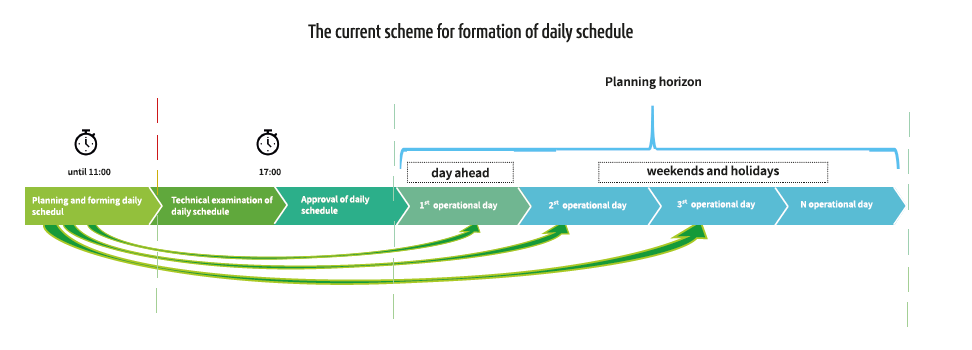
It is important to note that the current scheme for formation of daily schedule in accordance with the legislation of the Republic of Kazakhstan assumes submission of formed daily schedule for all wholesale electricity market entities (including RES) until 11:00 of the day preceding the operational days by uploading application to web interface of the System Operator's planning system. Further, until 16:00 ofthe day, the System operator coordinates with the authorized dispatching units of neighboring states schedules of interstate contractual flows of electric energy and conducts technical examination of daily schedule with subsequent approval and posting it atthe website of planning system until 17:00.
The graphs below show examples of deviations in electricity generation of solar and wind power plants from the planned values in August and September of this year.
It is worth noting a tendency to minimize these deviations during formation of daily schedule a day in advance before the start of operating day, while forecastingfor weekends and holidays is done several days in advance and has a stick-slip nature. Such a direction of deviations is observed in many renewable energy facilities, and especially for SPP projects in winter.
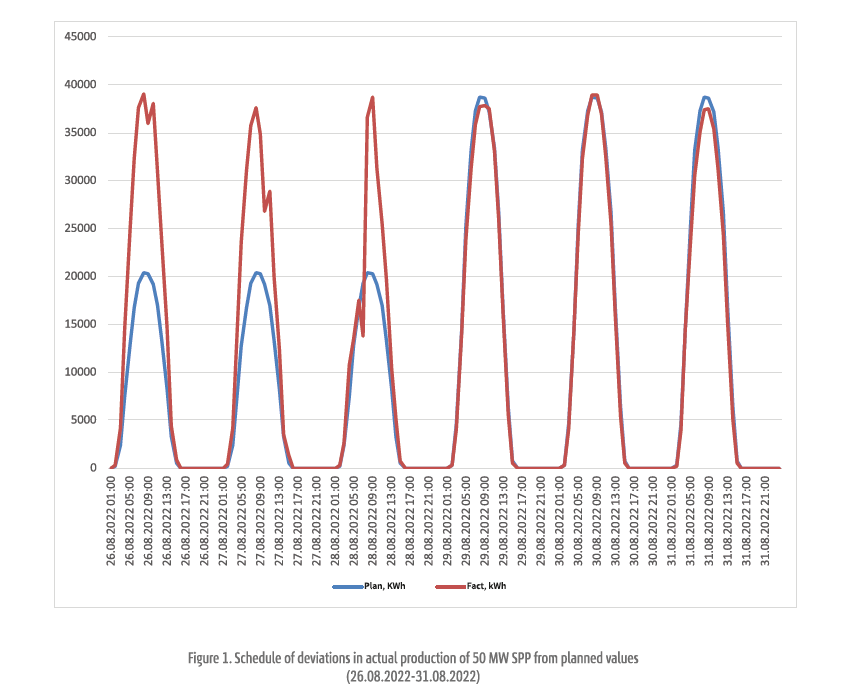
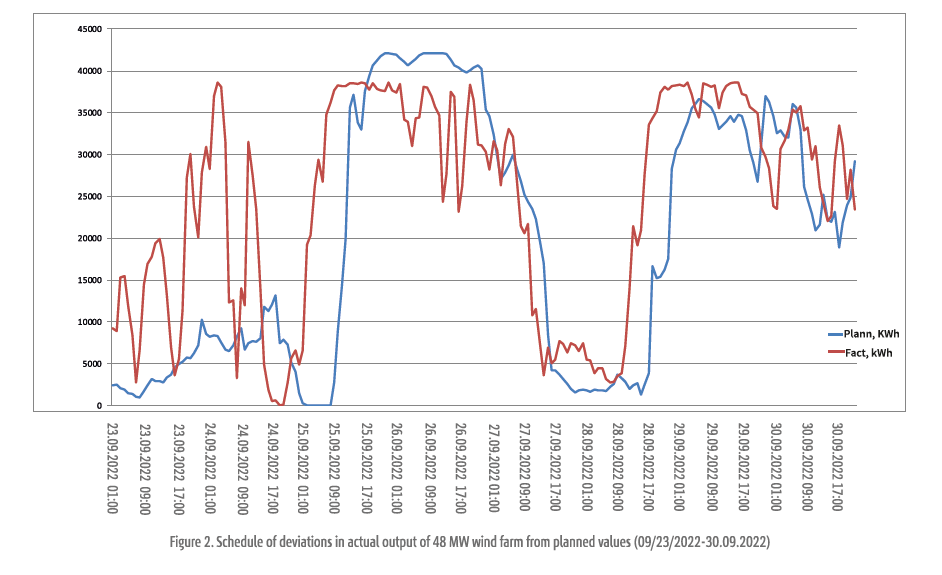
According to analytical data for 9 months of 2022, it was revealed that total imbalances from renewable energy facilities, both positive and negative, amounted to 1751 million kW with actual generation of 3504.4 million kWh! This fact indicates that there is a big problem in forecasting production of electric energy by renewable energy facilities and lack of financial instruments to stimulate their compliance. Sooner or later, this problem will lead to significant imbalances of electric energy during operation of Balancing Electricity Market in real time, increase in dependence on power system of the Russian Federation and financial risks on the side of RES balance provider. Out of total imbalances, SPPs account for about 489 million kW. or 28%, WPP -1182 million kW or 67%, HPP-79 million. kW or less than 1%.
The month of March is characterized by the peak of imbalances in energy system from renewable energy sources, which amounted to 249 million kW of underperformance, 220 million kW of over-production by all types of renewable energy sources.
The average hourly deviation by types of renewable energy for 9 months of 2022 looks as follows:
-SPPs-40.67%;
-WPPs-60.73%;
-HPP-22.88%;
The largest average deviations within specified period for SPPs fall to January - 62.02%, for WPPS - January, June, approx. 62%,for HPPs - January -27.30%. This factor is connected, in my opinion, with the seasonal difficulties offorecastingforSPPsand HPPs.
At the same time, the numberof hours with deviations from a certain range was:

3. PARTICIPATION OF RES IN BEM
Electric energy producers using renewable energy sources should already think today that when balancing market is operating in real time, all financial responsibility for imbalances created by them in the hourly daily schedule of electric energy production will be assigned to them.
One of the key factors in increasing integration of renewable energy variables into the energy system is the flexibility of the system. Flexibility is the ability of a system to respond to the variability and uncertainty of supply and demand. Higher flexibility of the system can be achieved in several ways. Figure 3 illustrates various options for increasing network flexibility at a relative cost.

According to the International Energy Agency (IEA), qualitative generation forecasting for renewable energy facilities is one of the most cost-effective ways to compensate for variability of output. Proper forecasting of RES provides the basis for using the full flexibility of traditional generation at the lowest cost without compromising reliability of the system. At the same time, it is important to note that RES forecasting is driver of the process, but in itself does not increase the network flexibility. Correct forecasting must be used in conjunction with other components. For example, increased system flexibility requires a combination of qualitative forecasting for RES, short-term economic dispatch control and sufficient flexibility of conventional energy installations.
Currently, the authorized body, the Ministry of Energy of the Republic of Kazakhstan, together with the electric energy market players is actively working to improve legislative framework in the field of electric power, for introduction of real-time balancing market and unified energy buyer mechanism. These proposed initiatives assume that all wholesale electricity market entities will independently bear financial responsibility to authorized organization at the BEM for deviation from planned modes of daily production and consumption schedule. RES facilities, not being an exception, will also be responsible for created imbalances, both through the balance provider (FSC of RE LLP) within the framework of the contract concluded with it, and independently within the framework of concluded bilateral agreements.
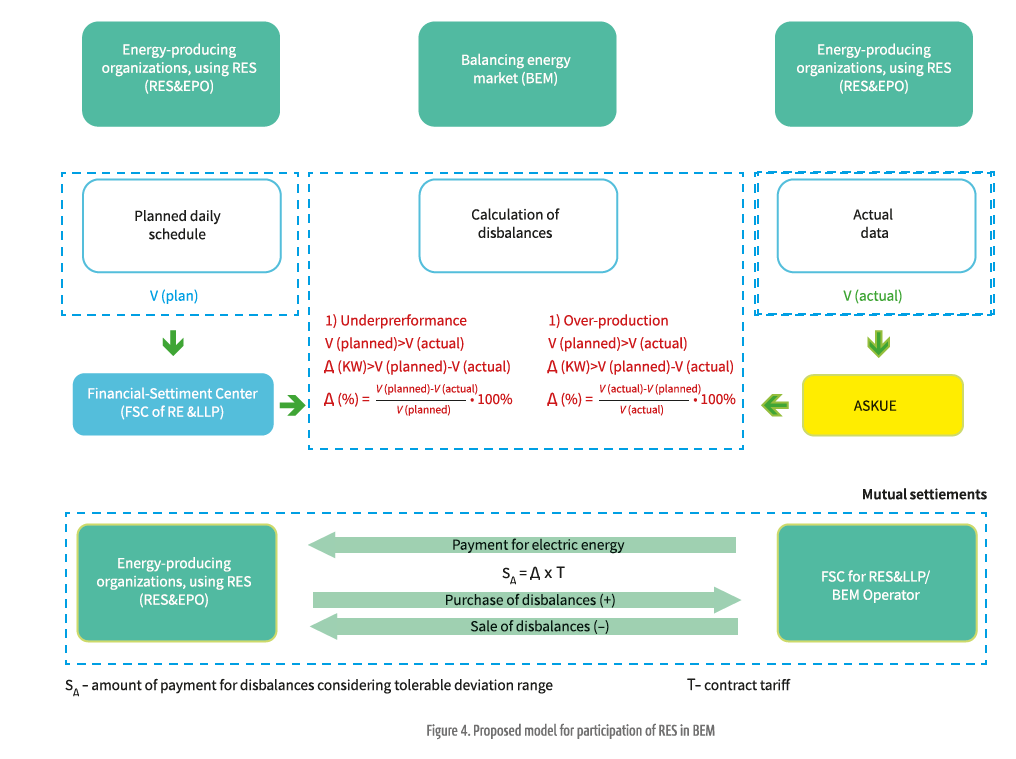
Production of a solar energy storage battery has started in Vilnius
Ainur Sosanova: Clear rules are needed for functioning of bilateral contracts market
Process to submit applications for RES auctions to construct HPPs and WPPs has commenced in Kazakhstan
JinkoSolar recognized as a Tier 1 Energy Storage Provider by BNEF
Japanese satellites will transmit solar power to Earth
Australia has planned a 1 GW hydroelectric power plant at former coal pit
Apple ramps up investment in clean energy and water around the world
Two countries in Europe are powered by 100% renewable energy as wind capacity soars
IRENA’s report: Transition to renewables calls for new approach to energy security
New wind power plant to be built in Baku
Cost of bringing wind power plants into operation drops by more than one-third
Energy ministers and leaders to discuss the future of renewable energy in Abu Dhabi
Hungary boasts the EU's largest geothermal system
EC adoped of the strengthened Energy Performance of Buildings Directive
90-GWh thermal energy storage facility could heat a city for a year
Europe embraces speedier, riskier way of building power grids
Former SpaceX, General Motors engineers turn to space-based solar power
The US just beat its goal to permit 25 GW of clean energy by 2025
New quantum material boosts solar cell efficiency to 190%
Astana hosted seminar of the USAID project “Energy of Central Asia”












